Disclaimer:
I fully understand the risks/dangers involved in these
adventures and do so in the full knowledge of what could happen. I don't
encourage or condone and I accept no responsibility for anyone else
following in my footsteps. Under UK law, trespass without force is a
civil offence. I never break into a
place, I never photograph a place that is currently occupied, as this would be morally wrong and intrusive, I never take any
items and I never cause any damage, as such no criminal offences have
been committed in the making of this blog. I will not disclose location. I leave the building as I find it and
only enter to take photographs for my own pleasure and to document the
building.
Today I'm having a mooch around this big derelict pottery. For me it ticks all the right boxes. It has historical significance, it has a story, it has some photogenic machinery, and it's an absolute death trap.
Pottery isn't something that I'm particularly passionate about though. But when you really think about it, they're fucking awesome! If it wasn't for them, I'd be cupping my hands under the tap whenever I was thirsty. And how would I ever have a coffee? A good coffee in the morning is probably the only thing standing between me and murder charges.
Beyond its practical usage, pottery can be ornamental too, and people do collect whole sets of tableware for the patterns and whatnot. That's not really my cup of tea, figuratively speaking, but I'm sure loads of other people love it.
What we have here is one of the last family-owned potteries in the UK, run consistently by the same family for over a century before its closure at the start of the 21st Century. This is a Victorian-era relic. An awesome scar from the Industrial Revolution casually rotting away.
Someone has painted some street art iver the old letterbox. If you want to see more of this artists work, the website is there.
While the buildings construction date is actually lost to me, annoyingly so. All the documentation online seems to start from the date when the Weatherby family got their hands on it, in the 1890s. The family name is still visible above the door, which surprised me somewhat, because after its closure it became a film set for a television series called Blue Dove, whereupon the show title was the name of the fictional pottery. I'm surprised they kept any reminders of any other titles visible. Presumably in the show, these signs were edited in post-production or simply kept out of shot. But I don't know, because there's very little about Blue Dove online. I've managed to hunt down a few clips and stock pictures, but that's it.
The entrance to the pottery leads into this big central courtyaed with the old offices on either side. There's still a sign on the wall that warns that only employees are allowed inside. Whoopsie!
There are also some noticeboards that display all the legalese involved with working in the pottery.
It is quite damaged, but this basically a regurgitation of the Electricty (Factories Act) Special Regulations, 1944, which can be found online for anyone who fancies wading through a wall of boring text.
And here we have the permissable hours of work documentation.
And here we have The Factories Act 1961, which was largely superseded by the Health & Safety at Work Act 1974. It basically defines what a factory is, and the health and safety regulations of running or being employed in one.
So now that the legal bollocks is out of the way (Don't worry if you didn't read it), let's get stuck in!
As mentioned, the Weatherbys came to this factory in 1892. Leading the way was the family big cheese, John Henry, a man who had been fatherless from the age of two. His father, Henry, had died of pneumonia in 1845, at just the age of twenty-seven, after heroically jumping into a canal lock to save a drowning child.
Johns uncle William had taken him in, and introduced him to the true family calling- not saving children from canals at all, but pottery!
This seems to be the Weatherbys purpose in life, the first potter of the family being the OG John who had left for London to become a potter back in 1726. He eventually died in 1758, but not before shooting his DNA into a woman and spawning a lineage that would remain potters right up until the 21st Century.
John Henry married the love of his life, Mary, in 1864, and had two sons, Samuel in 1866 and John Henry Jr in 1869.
I always thought the custom was to name the firstborn after oneself, to create that continuity of sorts. I seems a little odd that John Henrys second son would be the one amed after him. Perhaps he ran out of name ideas.
In 1882 John Henry became the third partner in a pottery, but this all fell apart in 1891. It was at this point that he set his sights on running a pottery of his own. By then Samuel was 25 and John Jr was 22, so they naturally got involved in the family trade too. John Henry must have been good to work for, because a load of his former employees decided to tag along to the new place.
Initially this wasn't to be the seat of John Henrys pottery empire. First he obtained land somewhere else entirely, intent on building a pottery from scratch. But the locals weren't too happy with him building a pottery there, and raised objections out of concern for their fresh air, so John Henry eventually sold that land and took a lease out on an already established factory. But certain requirments in the leasing agreement made the factory somewhat unviable financially, none of which is stuff I know anything about. I'm a blogger, not a Victorian leaserer. And so John Henry left that factory and came here.
By all accounts it was a bit of a financial gamble for him. He sold as much potteryas he could, but following a complicated legal skirmish about the lease, he ended up a bit financially drained. He and his sons packed all the stuff into wagons themselves to transport it here, being unable to afford transport. It's my understanding that this building was already derelict when John Henry got it in 1892, albeit nowhere near as bad as it is today. It's said that the furnaces were so damp, it took them three firings befoe they produced satisfactory results. But the Weatherbys persevered, and finally the factory was up and running. In September 1892 they sent out a letter to all of their customers notifying them of their change of address, advertising tea sets, dinner ware, toilet stuff and more, both plain and decorated, for home, foreign and colonial markets
This here is the last remaining original bottle kiln, although when I say remaining, I use the term loosely. This former bottle kiln was built in 1906, meaning it was one of the last ones built by John Henry. When he first got the place, there were four kilns, and he immedately had two more built straight away. By 1900 there were eight kilns, so I guess this would have been the ninth. But from 1925 there were only five bottle kilns, and by 1961 this was the only one still standing, the rest gradually being retired for the preference of electrical kilns following the Clean Air Act of 1956, which was passed in retaliation to Londons "Great Smog" of 1952.
This particular kiln was used for the last time in 1965, and then it became ornamental. It actually became a listed building in 1989, but apparently nobody cared enough to try and preserve it, and it collapsed in 2012.
Stock imagery for the Blue Dove TV show do show the bottle kiln in its pre-collapsed condition, taken roughly around 2001.
(Picture not mine, obviously)
It's still possible to slip inside the old kiln.
It's damaged externally, but it hasn't collapsed internally. Perhaps it can be saved.
There's some stairs here that actually lead up to the best part of any abandoned building, the toilets. But these blue stairs are partially rotted away, which means if you do need to go, it might be safer to go behind that bush.
Interestingly enough this stairway can be briefly seen in the first episode of Blue Dove
And this is honestly the clearest screenshot I could get, but it's still recognisable! Another stock photo shows the characters in front of the steps.
(Photo not mine, obviously)
This is the area at the top of the blue staircase. There's a few derelict offices, but this part has clearly been set on fire and is notably less safe than other parts of the factory. But how else was I supposed to see the best part of any abandoned building?
Still in better condition than the toilets in some pubs and cubs.
So it's through here that we get to all the cool machines and stuff, but first, I want to show that this particular portion was also seen in the first episode of Blue Dove. The difference is it was given this big blue frontage.
I'm not sure if the big blue frontage is part o the film set, seeing as Blue Dove was the name of the pottery in the show, or if this is was an existing feature when the pottery was still running. Unfortunately this TV show is the closest thing I can find to modern shots of the pottery prior to it being abandoned.
Slipping inside, the pottery is a vast industrial wasteland, with much of the machinery still here.
I have no idea what any of this was for, but it looks cool.
By the 20th Century, the pottery was a huge success. In 1910, John Henry had a house for his family built and it remains in the family to this day. There was allegedly a fire at the pottery around that time, and about two hundred employees went without work temporarily, but the building was insured and they bounced back. In 1914, John Henry was getting on a bit, and he decided to retire.He left the pottery in the capable hands of Samuel and John Jr.
He also married a woman called Annie, and together they spawned John Stuart.
Samuels brother, John Jr, was also fruitful, spawning a son named John Lukas with his wife Florence. He was directly responsible for sales and marketing, and traveled the country with various samples. He eventually became a chairman, and he came to the factory every day until he was 82.
I think these blue things are ovens.
I'm not sure what this blue bowl contraption is.
There are a number of ovens big enough to enter that were about as big as toilet cubicles. The doors were big and heavy, and in theory it would be entirely possible to lock someone in one.
Back when the factory was operational, these rooms must have come to extraordinsry temperatures.
A lot of the shelves are still in the warehouse. Only a few decades ago these would have been full of pottery.
This is interesting. It's part of a ceramic mould. There would have been two halves of this and they would have shaped the material inside into the pattern.
Samuels son, John Stuart, joined the family business in 1924 and was personally tutored by Samuel himself. Such a choice, in spite of there being a couple hundred employees, certainly indicates that John Stuart was being prepped to take over the business from the start. He married a woman named Yvonne, and he had two sons, Christopher and Jonathan.
It was also in 1924 that the original big cheese, John Henry, celebrated his diamond wedding anniversary, and even though he'd been out of the company for a good decade, a lot of the potterys employees attended the celebration evening. It honestly has the vibe of one big happy family. Many of the employees had children who also went on to work at the pottery.
The factory eventually opens up to a smallyard around the back, but it's pretty barren
Interestingly, during the 1930s it became popular for any tableware decorated by artwork to be signed by the artist. I guess this gave it a more personal touch, and collectors could support their favourite artists. Nowadays such things could perhaps be considered collectors items in some circles. It does kinda make sense.
What doesn't make sense is that one of the guys in charge, Jim Hammond, insisted that the artists use psudonyms that he came up with himself. So any pottery painted by, for example, C Trent, was in fact painted by a woman called Dorothy.
I'm not sure why they had artist pseudonyms. It seems a little weird.
Dorothy worked here from 1926 until 1980, taking a short pottery hiatus from 1943 til 1945 to help the war effort. She wasn't the only worker here to get snapped up for the war, either. In 1938 there were rougly two hundred people working here, and then that number plummeted. It was during ths time that machinery started to get widely used throughout the pottery, in order to make up for the lost manpower. Some job roles, such as the "Decorating Manager" were simply made redundant, and just never filled again even after the war ended.
It was in 1930 that John Jr's son, John Lukas joined the company. He was personally trained by his uncle Samuel. Like his father and grandfather, John Lukas also proved to be quite
popular, and was gifted with a gold watch on behalf of the workers in
1935. But in 1937 he took off overseas to increase trade in other
countrys.
There was some sadness in 1933 when the founder, John Henry, passed away at the age of ninety. He was considered the oldest master potter in the country, having started out at the very bottom rung of the ladder and worked his way to the top. His firstborn, Samuel, then passed away in 1938 at the age of 72, having held the role of senior director. As such his son John Stuart became the new director. The inenviable task of navigating a company through wartime with a depleted crew fell on his shoulders.
There's a staircase going up the back of the building, but on closer inspection I soon realised it probably wasn't going to support my weight.
Beneath the stairs is this tunnel, which leads to all the old utility bits, the electrical cupboards and whatnot. Through here it is possible to re-enter the factory too.
There's a solitary oven here, which is weird because until now they've all been clumped together in the same areas. But what's really interesting is all the smashed pottery littering the ground. When the pottery closed down, anything that couldn;t be sold was just left, and then over the past two decades of the building being wide open, people have smashed it.
There's some dodgy looking stairs over there.
More smashed pottery.
As World War Two plodded on, the chap who was selling the pottery overseas, John Lukas, decided to join the RAF in 1941, so that he could add "Killing Nazis" to his CV. He returned in 1945, and became director of the pottery.
I have no idea why his cousin, John Stuart, stepped down, but John Lukas took to the job like a fish to water and instantly started dragging the factory into the modern era, removing the classic bottle kilns and replacing them with the electric and gas ones. For some reason, he decided against removing the final bottle kiln. Perhaps he wanted to have a final remnant of the potterys Victorian roots.
Given that humans can be quite change resistant, it would be interesting to know how the staff reacted to these changes. No doubt this revolutionised the potter industry, but when the old practices have been in place for so long, there was sure to be some people who grumbled.
Interestingly there was a fire in the decorating suite in 1949 but I'm not sure what caused it. From what I gather it completely gutted that portion of the building and it had to be rebuilt. I'm not sure which part of this building it was.
So, it's finally time to head upstairs and check that out. Given the condition of the building, it's likely a death trap, and that wasn't going to stop me. In fact I was eager to see just how high I could go.
As you can see, the roof is full on missing in some parts of the pottery, and nature has started taking it all back.
In my opinion by far one of the oddest products of the pottery came in the 1960s. It was called "Nursery Ware" and everything was decorated with creepy children. I managed to hunt down a photo of an example too!
I'm sure someone out there must find this endearing.
There wre various other themed lines of tableware too, and on special occasions they'd release commemorative mugs. In 1935 they produced mugs celebrating the silver Jubilee of King George and Mary, and they also did some to commemorate the coronation of the current overlord, Lizzie, in 1953, and also for her silver jubilee in 1977.
More exlusive mugs were made for Charles and Diana's wedding in 1981, and also for the royal visit to the Caymen Islands in 1983.
Outside of the realms of practical use, they also produced ornaments. From 1957 until the 1970s they produced "Zookies." These were apparently an attempt to compete with another company who produced very intricate, realistic porcelain animals called Whimsies. In contrast to that, Zookies were ornamental animals with cartoonish proportions and bright happy Disney eyes.
(Photo not mine, obviously)
What interests me is that this style does look familiar, but I can't place where I know it from. It has a very childhood nostalgia vibe to it that makes me wonder if my grandmother had a zookie or something. It would make sense. They were very popular and collectable. And if you've ever seen one, it was made in this building.
The company followed up with Beasties in 1958, which were collectable porcelain prehistoric reptile ornaments. So one could decorate their mantlepiece with Elasmosaurus, Stegosaurus, and Prince Philip.
They also produced ornamental Snow White dwarfs and Chuckleheads, which were mugs shaped like animal heads.
Upstairs in the pottery I found something quite awesome. There was an old store room full of mountains of pottery.
It's pretty cool. And the number 44 on the wall there is an original feature too, but I have no idea what it represents.
Someone has written that they've just had sex here, and they've also drawn a swastika completely wrong.
This seems to be an old workshop.
Here we have the obligatory abandoned building penis graffiti. I actually really like the detail on this, but I've never understood why people draw the urethra like a gash that encompasses the width of the head. The head of a penis isn't Pacman. It would be cool if it was though!
So in the latter decades of the potterys life, the last son of the original Big Cheese, John Jr, passed away in 1954, at the age of 85. Even though the reigns of the factory had long since been handed over to the younger generation, he'd still had his involvement and he'd witnessed the business he'd helped create grow and thrive
In 1972, John Stuarts son, Christopher took over the company, bringing with him ten years of experience teaching companies about computer use, which would further push the pottery into the modern era. Christophers brother, Johnathan, also joined the company in 1970, originally working on the clay production side of things before getting into decorating,and then finally becoming the sales director.
From 1975, they began producing stuff for the American importers, Jonroth, a company that I think may still be going today. I also think Jonathan may have ended up working there following this potterys closure.
Some of the shelves in the warehouse are still numbered.
Some more broken pottery
This room was clearly an office of some sort.
At the back of the office are some relatively safe stairs.
In the end, it was this stairway that I decided was my best chance of making it to the top floor and back again without dying.
However I soon discovered that while the stairs were okay, the floor could be trusted to support my weight about as much as Kate McCann can be trusted to babysit. This was some seriously dodgy floor.
There's a nice little cupboard up here though, still on its hinges, inaccessible to anyone with a survival instinct.
And here is a good example of how dilapidated the top floor is. This isn't the rooftop, but the ceiling and walls have collapsed, completely exposing this area to the elements.
Allegedly the top floor was a show and sample area, sort of like a walk-in catalogue of the the factories products. Many of the shelves are still up here, even though the walls and roof are not.
Heading back to the lower floor...
Here's an old filing cabinet.
More shelves. This part of the upper floors was allegedly a stockroom.
Alas, in the 1990s, things started to go downhill for the pottery. John Stuart was forced to retire in 1992 after he lost his eyesight. John Lukas passed away in 1993. This family-run pottery was seriously struggling against their competition in larger commercial businesses, particularly in hotelware. They simply couldn't keep up with the mass production of larger factories. By 1999 there were only fifty employees and this dropped to 10 in only a year. Christopher decided to close the business before they were forced to, while they were solvent rather than insolvent.
He actually passed away from leukemia a few years ago.
When the factory closed down, it was used briefly as a film set for the series Blue Dove, and I think Jonroth may have used it for a bit, but then when these folks were done with it, it was just left to the forces of nature. And nature has not been kind!
One strong testament to just how good is was to work here is that many workers didn't retire completely, with many still making appearances and pulling their weight long into their 80s. It was not at all uncommon for entire families to get jobs here, with parents procuring employment for their offspring once they were of suitable age. It might look like a shell now, but this building is going to hold many fond memories for hundreds, maybe thousands of people, many of which are still alive today.
And here's some very telling graffiti. "Graffiti and Urbex."
See, I'm not opposed to graffiti when it's art. Silly tags make no sense to me. It's like urinating on walls. It's how dogs let other dogs know that they're around, which of course is a compulsion that can be traced back to wolves marking their territory.
You're not a wolf, you're a teenager whose parents are siblings.
But this is also important because "urbexers" generally have an ideology of leaving things as they find it, and many decent urbexers will not disclose locations because they don't want to be part of the problem, where a location becomes widespread public knowledge and ultimately gets looted and destroyed by idiots who call themselves urbexers. And when people explore a pristine location with plenty of stuff that could fill an ebay account, or even something awesome like a huge underground bunker that would look perfect on someone elses youtube channel, if that person then refuses to disclose where it is, there can be a little bit of a petty backlash, with those who don't want to find places themselves (because that takes too long and they need social media content NOW for that Like-induced dopamine) often uttering the phrase "It's not urbexers who vandalise, it's local kids."
Which is obviously wrong. There are abandoned houses that have been remote, and miles away from local kids, left pristine for decades until the urbex scene trades the co-ordinates around like Pokemon cards and the place lasts about two weeks.
And this graffiti, even though it's not in a pristine, remote location, does prove the point, that there are folks in the urbex scene who do vandalise. Sure, it's in a factory, and not some remote cottage, but the point still stands.
There's the frame of an old workbench in front of what used to be a window.
This part of the upper floor seems to be the most stable, and the windows are relatively intact, so I think it's appropriate to share some then-and-now shots. Obviously given the condition of the factory, and the sheer size of it, it is impossible to match vintage photographs with specific areas, but this one has enough similarities to show vintage images and get a basic idea of what it might have looked like.
(Photo not mine, obviously)
This is the colouring room in 1914. Check out the vintage uniforms.
(Photo not mine, obviously)
Here are some women making cups and bowls in 1931.
(Photo not mine, obviously)
And here's another shot from 1931.
As I've said, it's impossible to match these to specific rooms, but it is the same building, and that is kinda cool.
From this floor it was possible to see this tower-like structure with a walkway around it and a giant wheel attached. I have no idea what this is, and much to my dismay, there actually wasn't a way up to it anymore. But I could probably still get pretty close!
Nearby is this really dodgy external staircase, which brings us out at the top floor, once again, coming out through this green/yellow door.
And there's that wheel once again, across a pretty big drop.
This is as close as we can get to the giant wheel. Clearly it is part of some old factory mechanism, no doubt hidden away in that little tower bit. But there's no way in.
Sure is pretty though!
And from up here we can look out over the factory and see just how fucked it actually is.
More parts of what would have been the display area, where the walls and roof have completely fallen away.
"Fuck your gang tag."
Finally, graffiti that makes sense to me!
I'm not sure what those big grey bins would have been used for, but since they don't look at all ideal for storing pottery, I'm guessing people just tossed the broken or inadequate stuff into them.
There's a couple more offices here, and they are joined by an internal window.
And this brings us out at the yellow metal stairway that I saw from ground floor earlier.
I think this is an old pottery wheel. Someone would have sat at this desk, and the wheel would have rotated while the worker would then mould the clay on top as it went around. It's so cool that it's still here.
Allegedly the original John Henrys wheel was kept in the building long after he died, as a tribute to the potterys founder. Whether it was ever removed or not, I don't know.
Here we have actual tracks leading up to the kilns. Presumably there were car loaded with stock for mass-cooking.
These would have reached extraordinary temperatures.
This part of the ground floor is underneath the most dilapidated parts of the upper floors, and it really shows. It's far more ruinous down here, but these metal beams seem to be holding up pretty well.
"Boris Hohnson is a nonce."
More good graffiti.
Here's some drug paraphernalia. I'm a very each-to-their-own kinda guy. I'm not really anti-drugs, so much as I don't see how they would benefit my life at all. But even so, I think once it's gone down the needle route, you're pretty much fucked.
Here's the old goods elevator, which is pretty cool.
Some covid-related graffiti.
Given the condition of the building it's probably not the smartest idea I've ever had to come down here, but hey-ho. If my ideas were really that bad, someone would time travel back from the future to stop me, right?
The cellar was a bit dull, but it had this old Victorian oven-ish thing down here, which is awesome.
And also this bloody awesome wheel.
But not being too knowledgeable on industrial stuff, I don't really know what any of it is for.
And that's all I've got.
In conclusion, it's actually kinda sad that a family-run business did so well once and was forced to end after centuries of working in that industry. This family has been in the pottery business since 1726, and that is impressive. Given that Jonathan went on to work for the company Jonroth, I do wonder if maybe the family is still active in the pottery industry elsewhere. But for this building, that's the end of the story. It's a shame really. It has a bottle kiln which is a listed building. It probably has many fond memories among the locals. You'd think more could be done with this place. With enough money and a lot of TLC, it could be a fantastic museum or community venue.
If you're an urbexer and you want to go here, be aware that it's an absolute death trap. Someday what remains of the upper floors is going to come crashing down, and nobody wants to be in here when it does. In addition to that is the needle issue. Wear suitable footwear.
My next blog will be a much smaller factory used to produce brooms. It sounds boring but the machinery is gorgeous. And then I'm doing a blog on an even prettier bar in the north.
In the meantime, follow me on Instagram, where I'm currently shadowbanned to shittery, Vero with its woefully tiny userbase but less shitty algorithm, Twitter which I just find pointless, Reddit which I don't mind., and Facebook, which is basically the social media equivalent of syphilis.
Thanks for reading!



































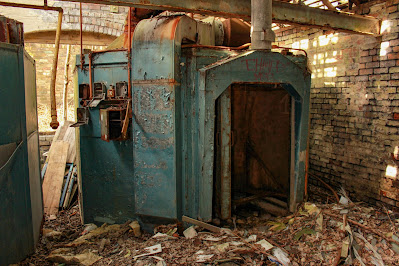





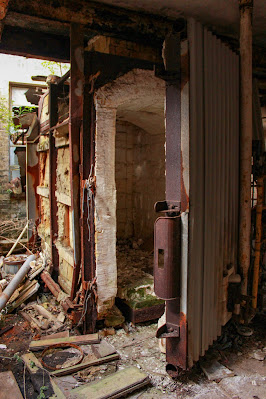






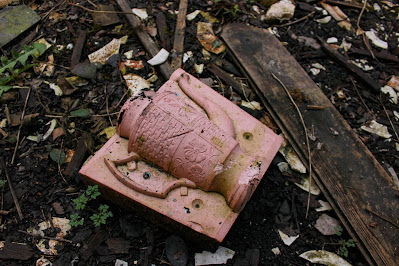





























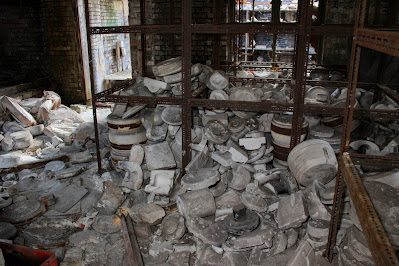




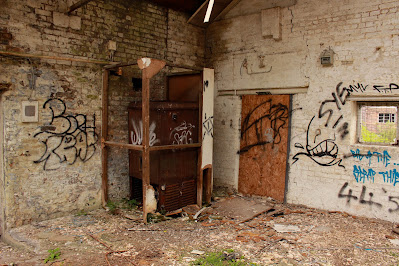

















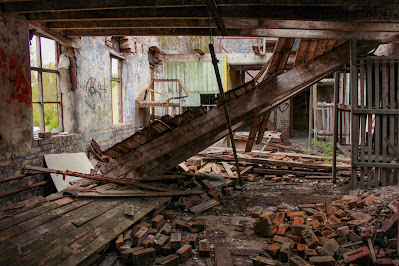
























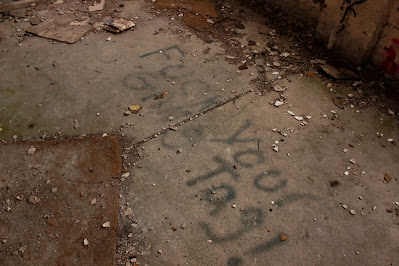

































No comments:
Post a Comment